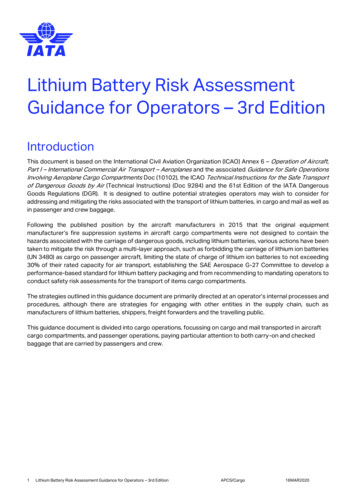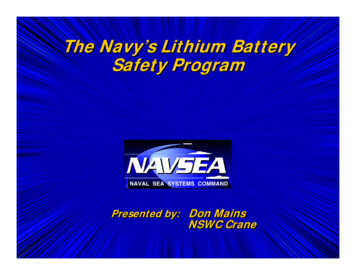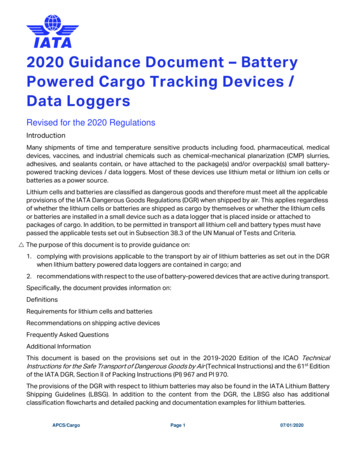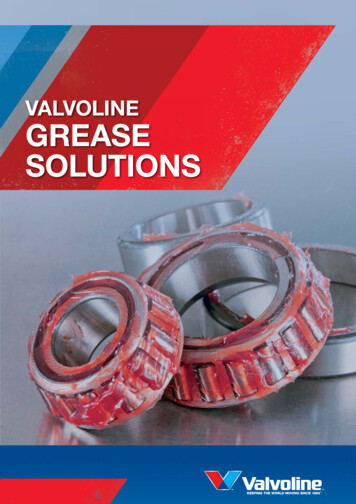
Transcription
Intelligent TestingMechanical Testing Solutions for Lithium-Ionbatteries in Automotive applicationsA. KoprivctestXpo 2017Mechanical testing solutions for Li-Ion batteries09/17cb-ak
ContentsLithium-ion batteries in automotiveapplicationsTests on lithium-ion batteriesMechanical tests on lithium-ionbatteriesZwick testing solutionsMechanical testing solutions for Li-Ion batteries209/17cb-ak
Battery usage in automotive applicationsLithium-ion batteries are used as the main rechargeableenergy source in electrical vehicles.Mechanical testing solutions for Li-Ion batteries309/17cb-ak
New components in E-CarsThe battery system and its components are the key elementsin an electric vehicle.SafetyMaterialsHigh VoltageCablesJoining technologySolar PanelChassisTransformerClimate ControlElectro motorEngine & Drive TrainBodyElectronics / MechatronicsBattery ChargerBattery cellsWheel HubMotorMechanical testing solutions for Li-Ion batteriesBattery n09/17cb-ak
Battery system componentsBattery systems are playing an important role in the performance ofelectric vehicles.Mechanical testing solutions for Li-Ion batteries509/17cb-ak
Battery system componentsTraction battery systems are typically made of cells which are combined inmodules. Additionally the systems require structural enclosures,management electronics, cabling and cooling.SystemCellModuleMechanical testing solutions for Li-Ion batteries609/17cb-ak
Working principle of a Lithium-ion batteryLithium-ion batteries are highly efficient energy storage deviceswhich allowed modern electric vehicles to become an alternativemobility solution. Cell components: Positive electrode (cathode)typically LiCoO2 or LiFePO4– coated aluminum Separator (polymer-film) Negative electrode (anode)typically graphite-coated copper Electrolyte During charging lithium-ions movefrom the positive electrode to thenegative electrode- energy is stored During discharge lithium-ions moveback from the negative electrode tothe positive electrode- energy is releasedMechanical testing solutions for Li-Ion batteries709/17cb-ak
Types of lithium-ion battery cellsLithium-ion battery cells come in different sizes and shapes.Batteries for electrical vehicles are bigger and store much moreenergy.Mechanical testing solutions for Li-Ion batteries809/17cb-ak
Design objectives for lithium-ion batteriesThere is a lot of effort going into the improvement of thebatteries and the search for the best compromise. Testing iscrucial for R&D as well as quality ightMechanical testing solutions for Li-Ion batteriesLife1009/17cb-ak
ContentsLithium-ion batteries in automotiveapplicationsTests on lithium-ion batteriesMechanical tests on lithium-ionbatteriesZwick testing solutionsMechanical testing solutions for Li-Ion batteries1109/17cb-ak
Testing of lithium-ion batteriesA wide range of tests is performed on high power lithium-ionbatteries for electrical vehicles. Types of tests: Incoming material inspection Electrical characterization * Ageing tests * Safety tests (*) Environmental tests Abuse tests (*)Overview of typical abuse tests: Typical standards: UN ECE 100 – R2 ISO 12405 - 1, 2, 3 SAND2005 – 3123 VW PV 8450 * not or partially in Zwick Roell portfolioMechanical testing solutions for Li-Ion batteries1209/17cb-ak
Mechanical tests on battery cellsAn electric-vehicle battery (EVB) is a high energy device thatrequires considerable precaution for testing to prevent anuncontrolled fire (thermal runaway). Various factors can influence the risk of a short circuit and a „thermal runaway“: State of charge (SOC) Chemical composition Mechanical damage Material quality Manufacturing quality Temperature Risk for operators and/or equipment has to belimited by: Isolating these critical tests in especiallyexplosion protected rooms Vibration Using special temperature chambers which addan additional protection Design Ideally a combination of both Mechanical testing solutions for Li-Ion batteries1309/17cb-ak
ContentsLithium-ion batteries in automotiveapplicationsTests on lithium-ion batteriesMechanical tests on lithium-ionbatteriesZwick testing solutionsMechanical testing solutions for Li-Ion batteries1409/17cb-ak
Design objective for battery impact protectionDesign goal for no-fire should be minimizing risk of shortcircuit while tolerating certain level of deformationImpact deformation Damage Short circuit Heat accumulation Thermal runaway (fire)Mechanical testing solutions for Li-Ion batteries1509/17cb-ak
Li-ion battery – Cell integrityCharacterizing and modeling failures of battery materials andshort circuit of battery cells94.09083.5803.070652.041.5 indentation increaseforce peakvoltage droptemperature rise326050401.0300.5200.060010432Indentation distance (mm)2.5Temperature (oC)Force (kN)6Cell Voltage (V)5711001002003004005000Time (s)ForceIndentation distanceVoltageTemperatureLuo, Jiang, Xia, Zhou. Fracture mode analysis of lithium-ion battery undermechanical loading. 2015 ASME Congress. IMECE2015-52595.Mechanical testing solutions for Li-Ion batteries1609/17cb-ak
Li-ion battery – Cell materialsHighly automated production processes require a goodunderstanding of material characteristics Components/layers of battery cells: Coated and uncoated plastic films(anode, cathode, separators, enclosure) Coating quality (Graphite, Lithium Cobalt Oxide) Aluminum, Copper foil Electrolyte (liquid/solid) Connectors, weld tabs, Tests are performed under various environmental conditions, i.e. Temperature (e.g. -40 / 100 C) Humidity Chemical influence Mechanical damage Etc Mechanical testing solutions for Li-Ion batteries1709/17cb-ak
Li-ion battery – Cell materialsVarious standard testing solutions fulfill the requirements forbetter characterization of battery cell componentsTensilePunctureFrictionHorizontal tensile2-point flexureTensile creep in bath90 Peel / DelaminationBi-axial test in bathMechanical testing solutions for Li-Ion batteries18Automation09/17cb-ak
Li-ion battery – Cell materialsTesting surface coating adhesion (Graphite and lithium cobaltoxide) on anodes and cathodes of lithium-ion cellsDescription:determine the surface adhesion forcesof electrode coatingZwick solution: Machine: Z010 Allround-Linewith testControl II electronics Fast (2000 Hz) synchronousmeasured-value acquisition Special Z-direction tensile fixtureto measure adhesion forcesZ-direction tensile test on cathode coating High repeatability and throughput dueto up to 5 tests in one setupLi-Ion battery cell layersMechanical testing solutions for Li-Ion batteries1909/17cb-ak
Li-ion battery – Cell integrityBattery cells as smallest energy source entity need to satisfy anumber safety critical tests, especially under abuse conditions Mechanical tests at different states of charge and environmental conditions: Tensile, Torsion, (Static and Fatigue) 3-/4-point bending (Static and Fatigue) SOC Inflation/Deformation Forced short-circuit (Nail penetration test) Crush Drop * Impact * not in Zwick Roell portfolioMechanical testing solutions for Li-Ion batteries2009/17cb-ak
Li-ion battery – Cell integrityExamples of mechanical tests on lithium-ion pouch cellsNail penetration / ImpactPunctureFlat crush*Cardboard sample in place of pouch cellEdge crushMechanical testing solutions for Li-Ion batteries2109/17cb-ak
Li-ion battery – Cell researchExample of a test configuration for advanced material researchon lithium-ion and future technology battery cells Research objective: R&D on new materials for high energy battery cells Types of test: Tension, Flexure, Torsion (static and fatigue) Temperature Equipment: 2x Tension-Torsion (100 250 kN) 1x Fatigue loadframe (100 kN) 3x Temperature chamber (EUCAR 6) Special tooling for future cell design Integrated with room safety equipmentMechanical testing solutions for Li-Ion batteries2209/17cb-ak
Mechanical tests on battery cellsSpecial temperature chambers (EUCAR 6) protect operatorsand testing equipment.Universal Testing Machineequipped with safety temperaturechamberMechanical testing solutions for Li-Ion batteries2309/17cb-ak
Li-ion battery – ModulesBattery modules are comprised of several battery cells. Theintegrity of the module is of high importance. Battery modules/packs: Mechanical enclosure (Aluminum, Sheet metal, Plastics) Cabling Cooling Connectors Tests: Shock / Impact Crush Environmental Structural Abuse (*) Vibration * Electrical performance ** not in Zwick Roell portfolioMechanical testing solutions for Li-Ion batteries2409/17cb-ak
Li-ion battery – SystemEntire battery systems are typically tested for theirperformance in a vehicle in various conditions Entire battery systems: Mechanical enclosure (Aluminum, Sheet metal, Plastics) Cabling Cooling Connectors Tests: Shock tests Vibration tests Environmental tests Structural testsMechanical testing solutions for Li-Ion batteries2509/17cb-ak
ContentsLithium-ion batteries in automotiveapplicationsTests on lithium-ion batteriesMechanical tests on lithium-ionbatteriesZwick testing solutionsMechanical testing solutions for Li-Ion batteries2609/17cb-ak
Testing solutionsThrough constant innovation, we offer all componentsnecessary for professional material testing.DIRECT LINKS:Static testingmachinesFatigue mpactTestersPlastometersHDT-VicatSheet metaltestingRobotictestingExtensometersGrips &ToolingsLoad ical testing solutions for Li-Ion batteriestestXpo in UlmWhat is testing?27SAFETYReliable Test Results09/17cb-ak
Tests: Shock tests Vibration tests Environmental tests Structural tests. Mechanical testing solutions for Li-Ion batteries 09/17 cb-ak 26 Contents Lithium-ion batteries in automotive applications Tests on lithium-ion batteries Mechanical tests on lithium-ion batteries










